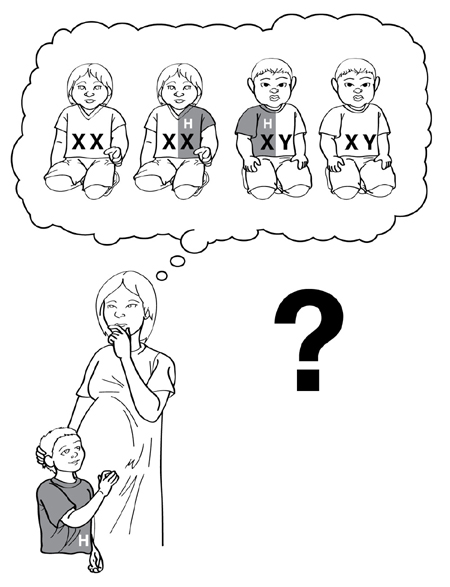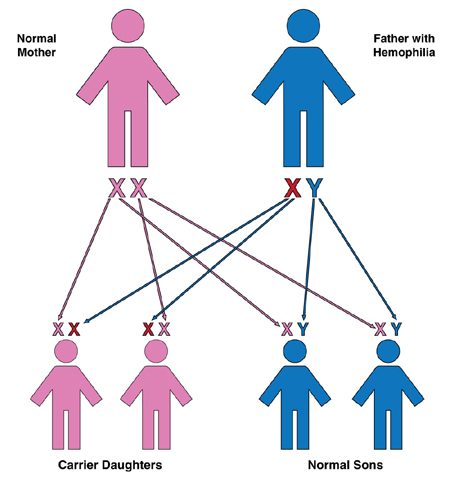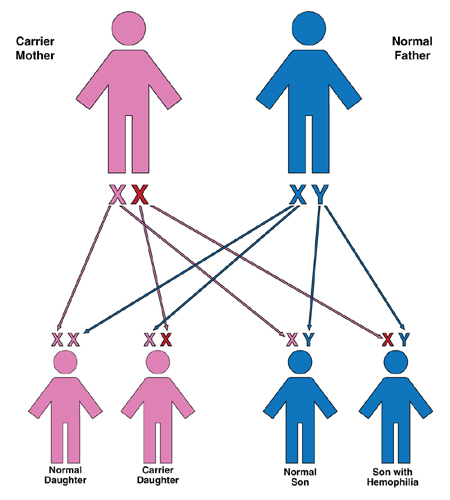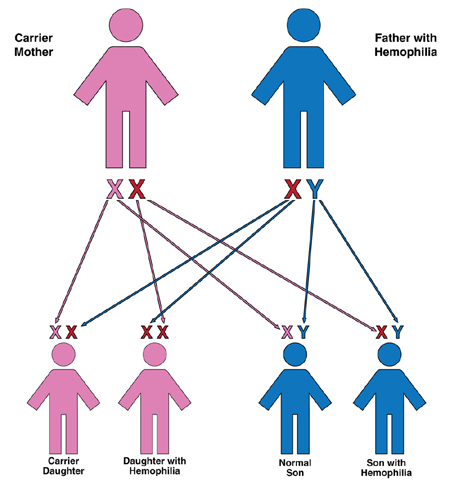Mom Is Homozygous Healthy, and Dad Is Hemophilic. What Is % Chance of Having a Hemophilic Baby?
How Hemophilia is Inherited
How are hemophilia A and B inherited (passed)?
The gene with the instructions for making factor is found only on the sex chromosome labeled X. If the gene is faulty, the result is hemophilia unless there is a dominant, normal gene on a matching X chromosome. Hemophilia is a sex-linked recessive disorder. These kinds of defects occur more often in men than in women. This section will explain all of this in more detail.
What is a hemophilia carrier?
A daughter gets an X chromosome from her mother and an X chromosome from her father. Suppose the X chromosome from her mother has the gene for normal blood clotting. Suppose the X chromosome from her father has the gene for hemophilia.
The daughter will not have hemophilia since the normal blood clotting gene from her mother is dominant. It won't allow the instructions from the hemophilia gene to be sent.
The daughter is called a carrier for hemophilia. She has the gene on one of her X chromosomes and could pass it on to her children. Does this mean that the mother alone is the one responsible for having a child with hemophilia?
Not really. The mother is the one who passes the hemophilia gene. However, it is the father's sperm that determines if the child will be a boy or a girl. It is not the "fault" of one parent since both parents contribute to the outcome.
All of us have dozens of abnormal genes. We are unaware of most of them. It is purely by chance that a hemophilia gene is passed on to produce a child with hemophilia.
What are the chances of having a child with hemophilia?
- No sons of a man with hemophilia will have hemophilia.
- All daughters of a man with hemophilia will be carriers (called obligate carriers).
- If a carrier has a son, the son has a 50% chance of having hemophilia.
- If a carrier has a daughter, the daughter has a 50% chance of being a carrier.
These four points are explained below. The percentage (%) or "risks" are based on large numbers of births. In other words, if 500 carriers each had two sons (1,000 total), we would expect there to be about 500 boys with hemophilia. But in that group there would be women who had two sons with hemophilia, women who had one with and one without, and women with no sons with hemophilia. The gene a child will inherit is based purely on chance and can never be truly predicted.
A child's chances of getting a hemophilia gene do not have anything to do with whether or not brothers or sisters have the gene. Each time a woman is pregnant, her chances of having a child with the hemophilia gene are the same (Figure 2-3). It is like rolling dice. The results of one roll do not affect the next roll.
A family may have children with the hemophilia gene and children without it. It is also possible for all the children in the family to inherit the normal gene or all to inherit the hemophilia gene.
Figure 2-3. For a mother who carries the hemophilia gene, the chances of giving birth to a child with hemophilia are the same for each pregnancy. Even though she already has a child with hemophilia, she can still give birth to another.

What are the chances of having a baby with hemophilia or who is a carrier if:
- the father has hemophilia
- the mother does not have hemophilia and is not a carrier
The father's sex chromosomes are labeled XY, with the X chromosome carrying the hemophilia gene. [In our drawings, we have shown this by putting an H for hemophilia over the X.] The father only passes half of his sex chromosomes to the baby, either the X or the Y.
If the baby gets the Y chromosome from the father it will be a boy. Since the Y chromosome does not carry the hemophilia gene, a son born to a man with hemophilia and a woman who is not a carrier will not have hemophilia.
If the baby gets the X chromosome from the father it will be a girl. The X chromosome from the father with hemophilia will have the hemophilia gene. But the girl also gets an X chromosome from her mother. The normal blood clotting gene on the X chromosome from the mother is dominant, so the baby girl will not have hemophilia. She will, however, be a hemophilia carrier since she has the hemophilia gene on one of her X chromosomes.
So in this case, all sons born to the couple will be normal and all daughters will be hemophilia carriers (Figure 2-4).
Figure 2-4. Father with hemophilia; mother with normal blood clotting gene. Follow the arrows to see the possible gene combinations.

What are the chances of having a baby with hemophilia or who is a carrier if:
-
The father does not have hemophilia
- The mother is a carrier
The father's sex chromosomes are labeled XY. The father only passes half of his sex chromosomes to the baby, either the X or the Y.
If the baby gets the Y chromosome from the father it will be a boy. The son can get from the mother either her X chromosome with the hemophilia gene or her X chromosome with the normal blood clotting gene.
If the son gets his mother's X chromosome with the hemophilia gene he will have hemophilia. If he inherits his mother's other X chromosome, he will have normal blood clotting. So a carrier's son has a 50% chance of having hemophilia.
A baby girl will inherit an X chromosome with a dominant gene for normal blood clotting from her father. So the daughter will not have hemophilia. A daughter will get either her mother's X chromosome with the hemophilia gene or her mother's X chromosome with the normal gene for clotting. If she gets the X chromosome with the hemophilia gene she will be a carrier. So a carrier's daughter has a 50% chance of being a carrier.
A woman who is a carrier has:
-
a 25% (one in four) chance of having a daughter who is a carrier
-
a 25% chance of having a son with hemophilia
-
and a 50% chance of having a child (boy or girl) who does not have the gene for hemophilia at all (Figure 2.5)
Figure 2-5. Father with normal gene; mother a carrier. Follow the arrows to see the possible gene combinations.

What are the chances of having a baby with hemophilia or who is a carrier if:
- The father has hemophilia
- The mother is a carrier
The father's sex chromosomes are labeled XY, with the X chromosome carrying the hemophilia gene. The father only passes half of his sex chromosomes to the baby, either the X or the Y.
If the baby gets the Y chromosome from the father it will be a boy. If the boy gets his mother's X chromosome with the hemophilia gene he will have hemophilia. If he inherits his mother's other X chromosome, he will have normal blood clotting.
If the baby gets the X chromosome from the father it will be a girl. The X chromosome from the father with hemophilia will have the hemophilia gene. The girl also gets an X chromosome from her mother. If she gets the normal X chromosome, the girl will be a carrier. If she gets the X chromosome with the hemophilia gene, she will have hemophilia.
A man who has hemophilia and a woman who is a carrier have:
- a 25% (one in four) chance of having a son with hemophilia
- a 25% chance of having a son with normal blood clotting
- a 25% chance of having a daughter who is a carrier
- a 25% chance of having a daughter who has hemophilia
This is shown in Figure 2-6. It is very rare for a man with hemophilia and a woman who is a carrier to get together. That is why there have been only a few girls born with hemophilia.
Figure 2-6. Father with hemophilia; mother a carrier. Follow the arrows to see the possible gene combinations.

How could hemophilia appear in a family that has no history of the disorder?
In some families, there is no known family history of hemophilia. The hemophilia gene seems to appear from nowhere and the family is shocked and confused.
There are several reasons this could happen. First, the family may not know about or may have forgotten ancestors with hemophilia. Second, the gene for hemophilia may have been passed down by carrier females without anyone knowing. For several generations, the women may have had no boy children or by chance had only normal boys. No one would have known about the hemophilia gene. Third, hemophilia may appear in families with no history of it if the normal blood clotting gene suddenly becomes messed up (a spontaneous genetic mutation).
What is a gene mutation?
Normally, genes are exactly copied generation after generation. Sometimes, though, a gene may become faulty. It may give different or wrong directions to the body. This change in the gene is called a mutation. The change is permanent - the gene won't be able to turn back to normal.
The effects of the faulty gene may be noticed right away. Or they might not be seen until the gene is passed on to a baby. So the change in the gene may have happened in the parent or in the baby.
The change in the gene can be caused by something in the environment. It also seems to happen without any clear cause. Since they are nature's way of bringing about change, not all gene mutations are harmful.
The hemophilia gene can occur in a man or woman this way. The blood clotting gene suddenly becomes faulty. The gene may be passed by female carriers for several generations before hemophilia appears in a boy baby.
If men with hemophilia and women who are carriers stopped having children, would hemophilia disappear forever?
Probably not. Mutations in blood clotting genes would still happen, making new carriers and new people with hemophilia. It is believed that as many as one-third of the babies born with hemophilia are caused by new gene mutations.
Once hemophilia is in a family, will it always be there?
Once the hemophilia gene is present, the chance of passing it on exists. It is possible, however, for hemophilia to disappear from the family tree. This can happen if all family members who have hemophilia or who carry the hemophilia gene give birth to children who by chance do not get the gene.
Can people with hemophilia in a family have different clotting factor levels (mild, moderate, or severe)?
The clotting factor level will be about the same from one generation to the next. So the daughters of a man with severe hemophilia will all carry the gene for severe. It won't change to mild or moderate. The same goes for men with mild and moderate hemophilia. Their children will all carry the same level.
Even though the level stays the same, hemophilia can have very different effects on the lives of people in the family. This is due to different lifestyles and treatments for hemophilia. For instance, a grandfather with hemophilia may have very bad joints and walk with a limp because he could not get treatment when he was young. His grandson may be running track on his high school team because early treatment with factor has kept his joints healthy.
Mom Is Homozygous Healthy, and Dad Is Hemophilic. What Is % Chance of Having a Hemophilic Baby?
Source: https://www.hog.org/handbook/section/2/how-hemophilia-is-inherited
0 Response to "Mom Is Homozygous Healthy, and Dad Is Hemophilic. What Is % Chance of Having a Hemophilic Baby?"
Post a Comment